Harrison’s Cave and Other Attractions in Central Barbados
Since arriving in Barbados a few days ago I have developed a hankering to get away from the coast and visit parts of Barbados that most beach bound tourists don’t see, starting with Harrison’s Cave and other attractions in central Barbados. To do this I have arranged to rent a car which has just been delivered to out hotel by a young lady from GL Rentals. The international car rental companies don’t operate in Barbados and it is customary to line up a rental through your hotel’s courtesy desk. Expect to pay about $85 USD a day and be sure to get the extra insurance. While you certainly don’t need it in the US or Canada if you have your own insurance, here it’s worth the $25 USD just to avoid any hassle if something does go wrong.
The primary objective of today’s excursion is Harrison’s Cave one of Barbados top attractions. I have mapped out a route, but fully expect we will get lost at least once or twice if Barbados’ road signs are as poor as most people who have driven here attest. In Barbados they drive on the left with the steering wheel on the right, but I’ve done it many times before and don’t expect any troubles. The car is a little fuscia coloured Kia Picanto that matches my golf shirt – at least something will be coordinated this morning.
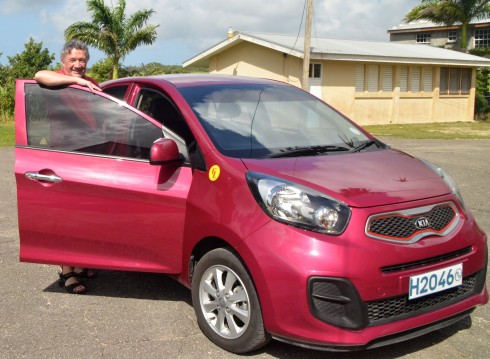
The first surprise is only moments in coming – there’s a bloody massive traffic jam! In order to get to Harrison’s Cave we need to take the Ernest Barrow Highway that bypasses Bridgetown, but it seems everybody else in Barbados has the same idea. It’s a four lane divided highway with a concrete barrier between the two directions so I can’t turn around and am forced, like a haji at Mecca to simply creep forward at the same snail’s pace as everyone else. So much for the tranquility of the Barbadian countryside. After a frustrating 45 minutes we finally get clear of the Bridgetown traffic at Warrens and head inland on a much narrower road.
Don Harding is the navigator and he is sure we are on the right road, but after a while it is apparent we have no clue where we are. True to expectations there are very few official road signs so every turn is an educated guess. There are lots of private signs indicating the way to various tourist attractions, but none for Harrison’s Cave. Still, the countryside is very nice with small villages here and there, sugar cane fields, small farms and the occasional planter’s house still in use. The further inland we go the higher the road rises. In the distance we see an old church and drive up to it to get our bearings. It is one hundred and fifty year old St. Ann’s (or Anne’s) in St. Joseph Parish and finding it on the map we realize we have overshot the mark by quite a bit. However, it’s a very nice building and well worth visiting.
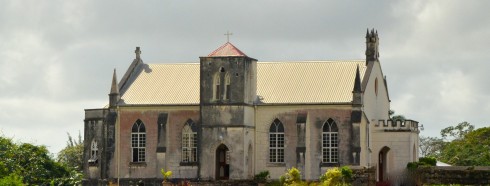
Recalculating, which you can actually do without a GPS, we start zigzagging northeast and notice that the farmland has given way to tropical forests and that in places the road has been cut straight through the coral so that there are steep banks on each side. At one junction we come across an amazing site that causes me to pull over. The coral on both sides of the road has been sculpted and painted into the shapes of animals. Getting out I see a plaque that identifies this as Procession.2002.
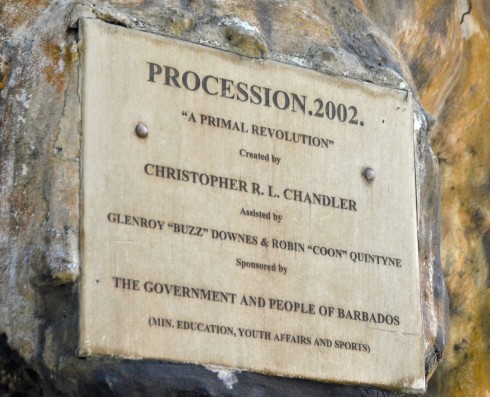
I can’t find anything more about it on the internet, but here are pictures of this amazing work, hidden away in the Barbadian forest.
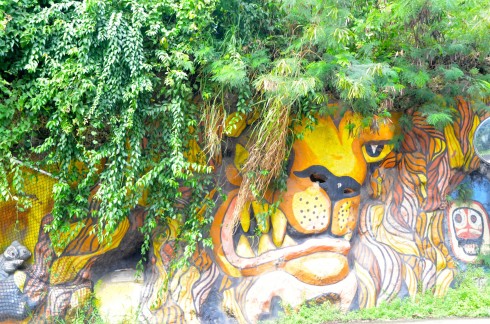
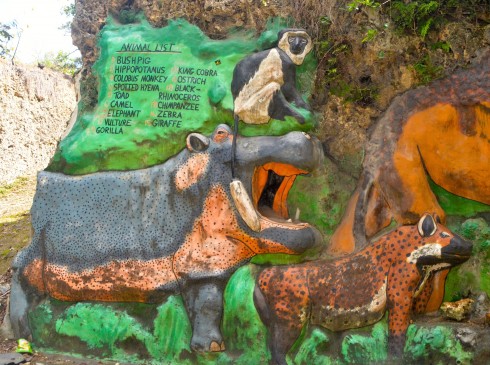
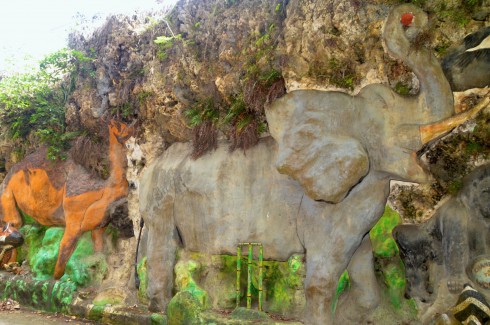
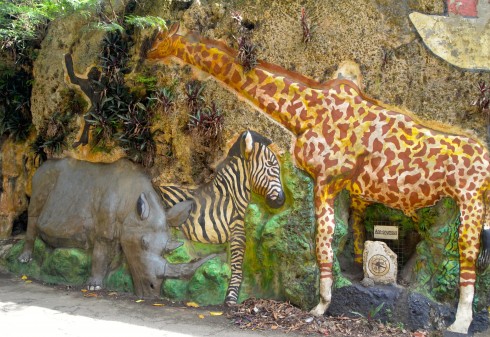
So there are benefits to getting lost. If we had gone the correct route we never would have seen this or the church. Not long after passing the Procession we start seeing signs for Harrison’s Cave and follow them through a series of steep up and downs onto an increasingly narrow road until we come to the entrance where there is a very modern looking series of buildings that seem almost oversized compared to the small dwellings that make up most of the homes in the area. Here’s Alison with Don and Helle at the entrance.
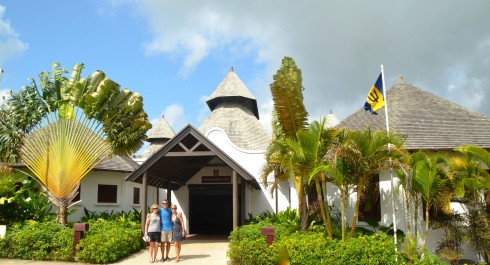
There are a couple of choices to make at the ticket booth – take the one hour tram ride through the cave or join a four hour eco-adventure tour that involves putting on head lamps and actually get down and dirty by crawling through narrow openings and walking underground rivers. I’m outvoted three-to-one and we by tram tickets for $30 USD. While I was impressed with the entrance buildings I’m even more impressed by the way you get down to the cave entrance. An eight story elevator has literally been attached to the side of a cliff and it takes you down to a lower level where there are more buildings including several handicraft huts and the building in front of the actual cave entrance. Essentially this is the bottom of a huge gully, one of many found in the mountainous north central part of the country.
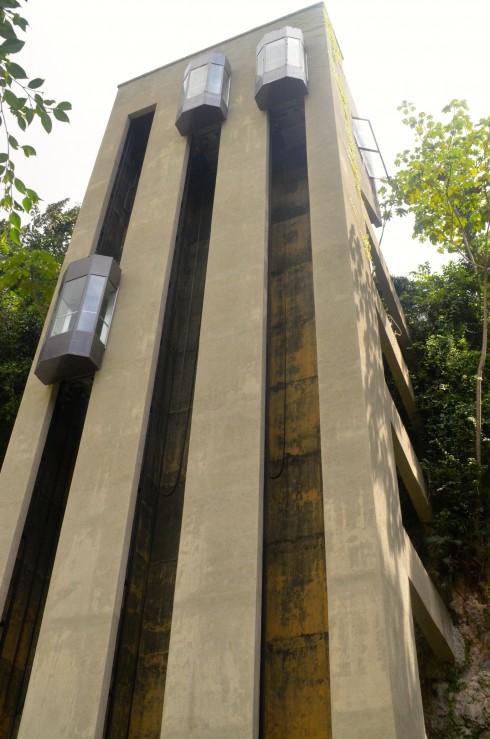
The tour begins with a short film on the geological history of Barbados and how Harrison’s Cave was created. It is the first time I truly grasped the reason why Barbados is so different from the other Caribbean islands. After the film we board tram cars which are pulled by a device similar to those that push back airplanes from the gate. On board is a driver and a guide, who I have to confess was at times barely understandable and we were in the front seats (I managed to get there by figuring out where the exit from the theatre was and sitting as close to it as possible). Her attitude was pretty blasé, but that did not affect the wonders we were about to see. Harrison’s Cave was actually known about since the late 1700’s, but it was not until 1974 that the cave was actually explored and mapped by Ole Sorensen, a Danish spelunker with the help of two Barbadian assistants.
The entrance to the cave is via what is no different than the entrance to most mines, an adit, which is simply a ramp that winds its way down to the ore body or in this case to the cave. It had to be a huge engineering project that would have cost tens of millions of dollars to construct. I sure hope the Barbadian government is getting a return on its investment. One of the first things I notice about this cave is that it is not cold. Every other cave I have ever been in gets progressively colder as you go deeper, but not Harrison’s which has an average temperature of 27 C or 80F, so you needn’t worry about bringing a sweater.
Finally we reach our first stalactite, a dandy hanging from the ceiling.
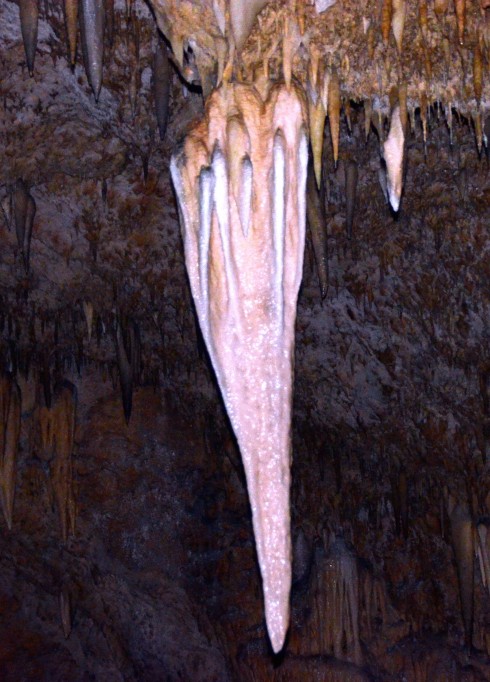
This is quickly followed by a family of stalagmites growing up from the floor.
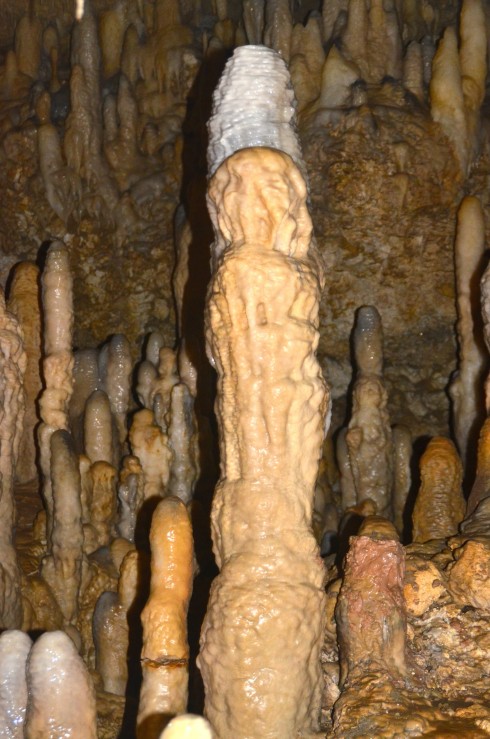
And then we came out to the tremendous sight of the Great Hall which is five stories high and covered with stalactites. Unfortunately it is impossible to get a decent picture of a huge cavern like this without almost super-professional equipment (I couldn’t even find one on the internet). So you will have to take my word that it is truly amazing and worth visiting just to see the Great Hall. The tram actually comes out near the top of the Great Hall and gradually winds its way downward and stops along the way for a closeup look at one of the underground rivers that run through the cave. Here are photos of what you might expect to see during the tram ride.
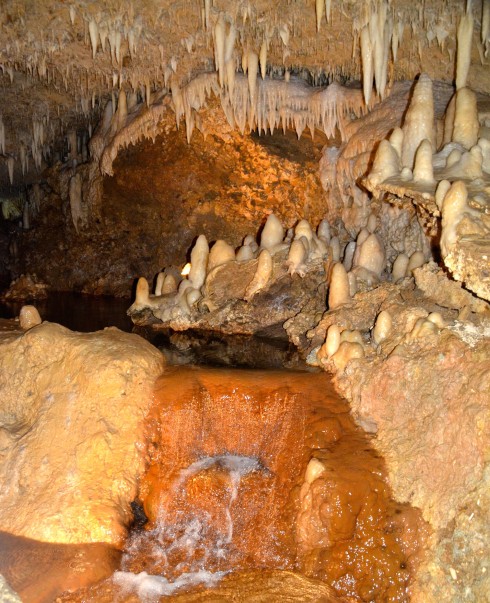
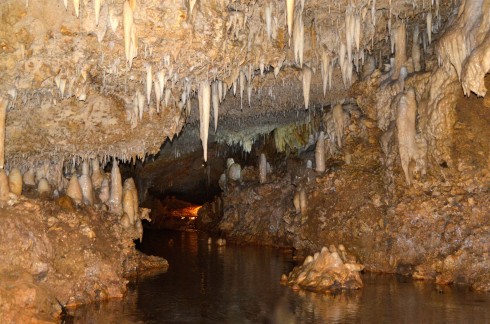
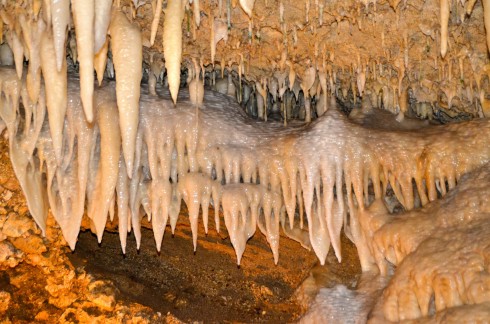
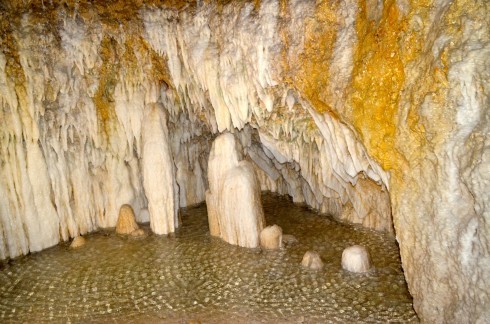
Somewhere during the journey we came across members of the eco-adventure descending a ladder into an underground pond. Looks like fun, right? Not according to Alison and Helle.
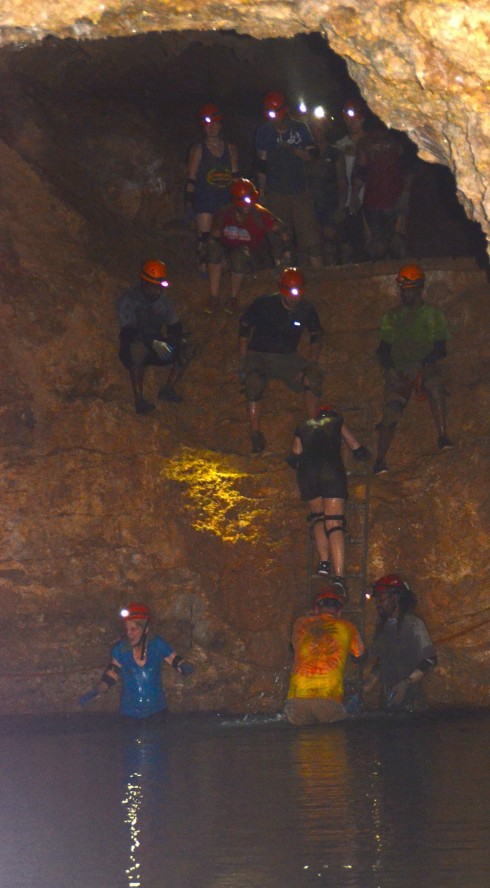
At one point the tram stopped for the obligatory turning out of the lights so that you experience true darkness – it’s always pretty creepy, especially when you think of early cave explorers armed only with torches that could easily blow out or flashlights with dying batteries.
After reaching the lowest point of the cave where the river disappears downward, perhaps into another as yet undiscovered cavern, the tram gradually makes its way back to the top and we stagger half blinded out into the glare of the midday sun.
Leaving Harrison’s Cave we head for the west coast making a stop at Barbados’ most famous pottery Earthworks along the way. It’s actually quite a large operation which explains why you find Earthworks goods for sale in just about every handicraft or souvenir store in the country. They are certainly very colourful.
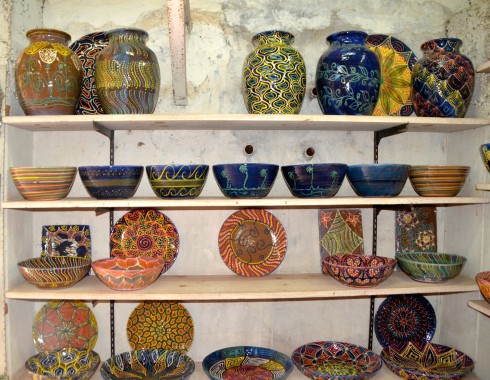
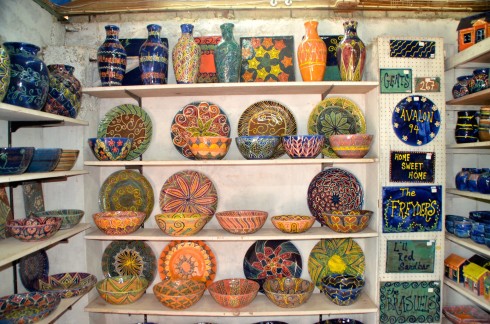
Sitting on this glass encrusted fence I could not help but think of the Spanish architect Antoni Gaudi and his beautiful work at Parc Guell in Barcelona. Here I am at the Earthworks wall.
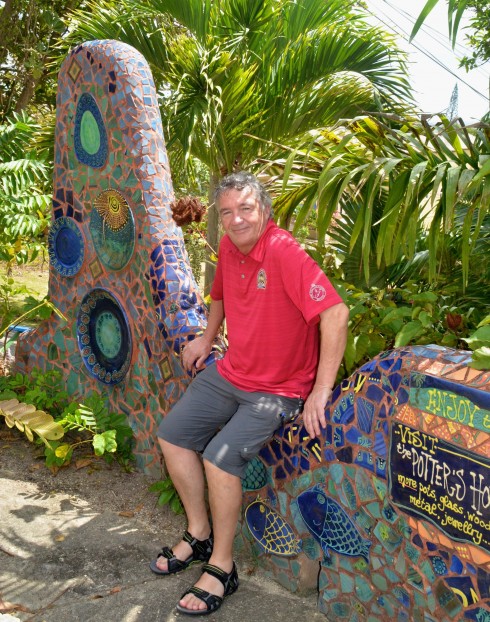
And here’s Alison in Parc Guell a few years ago. What do you think?
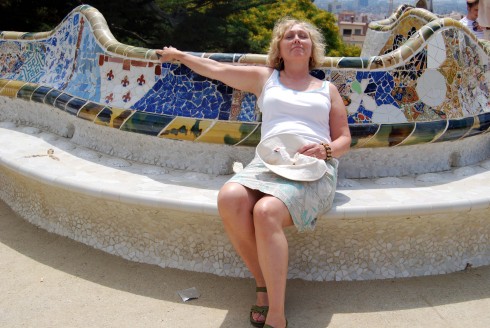
By now we were famished and headed for the coast coming out at Mullins Beach where Don and Helle recommended we eat at Mullins Beach Bar. It was a great choice – yet another Barbadian restaurant literally right on the water in a beautiful location overlooking spectacular Mullins Beach.
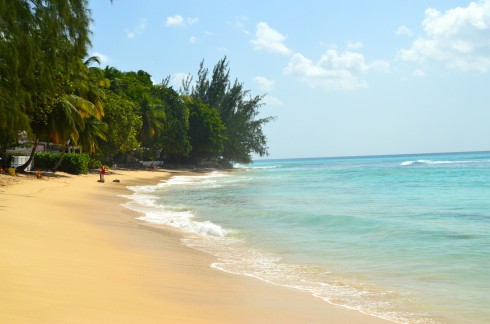
There was a short wait for a table which we occupied by people watching with a Banks in hand and studying the signpost over the bar.
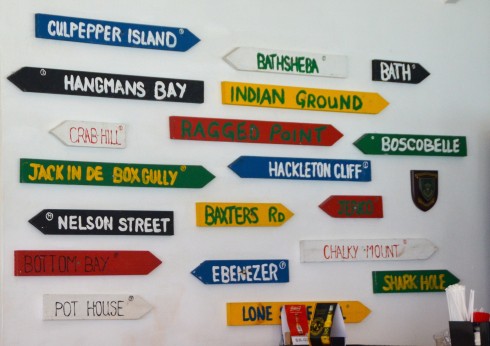
Mullins Beach Bar is known for its Bajan cuisine which explained why it was about a 50/50 mix between locals and tourists. For the first and definitely not the last time I had the national dish of Barbados, flying fish and cou cou, a combination of cornmeal and okra. Unbelievably good for such a simple dish.

After lunch we made our way back to the South Coast getting by Bridgetown without incident this time. Overall the driving was not a problem and I would recommend hiring a car at least one day during a Barbados holiday.
Next up is a visit to Barbados’ UNESCO World Heritage Site – Bridgetown Garrison. Please join us there.

